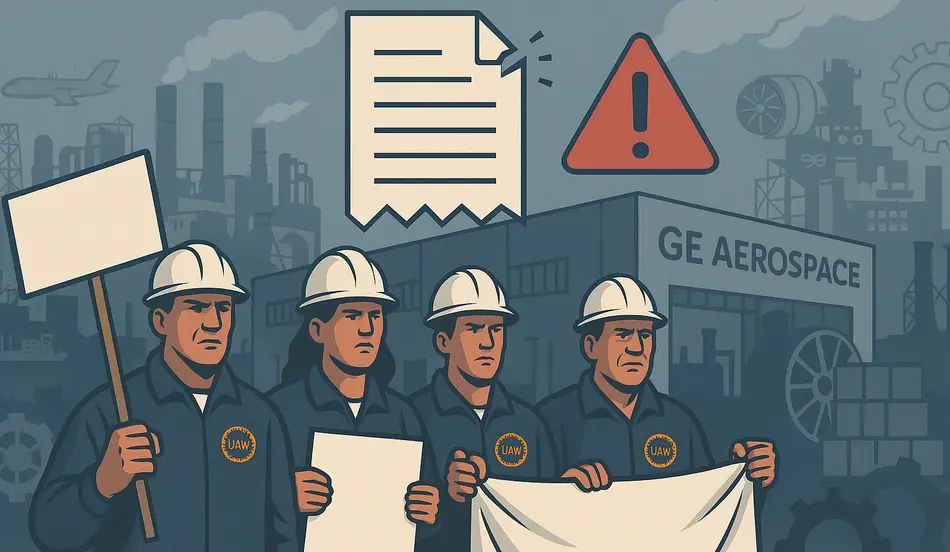For months, the simmering tensions between unionized workers and GE Aerospace leadership have been building. On August 27, as the clock struck midnight, the contract covering more than 600 members of UAW Local 647 officially expired. Hours later, workers at GE’s Evendale, Ohio production facility and its Erlanger, Kentucky distribution hub began strike actions after an overwhelming 84% vote in favor.
The reasons fueling the walkout are emblematic of broader labor unrest in America: spiraling healthcare costs, long hours with limited sick leave, wage stagnation despite record corporate profits, and the widening gulf between CEO compensation and everyday workers’ paychecks. For the UAW, this battle is about fairness, dignity, and sustainability. For GE Aerospace, it is about balancing costs while maintaining critical production for clients, including the U.S. military.
The strike could have profound implications—not just for GE, but for the broader aerospace industry, organized labor, and even national defense.
The Core of the Dispute
At the heart of the standoff are three major points of contention:
1. Healthcare Costs
Union leaders argue that GE’s latest contract proposal would raise employee health insurance costs by 36%–40%. For families already stretched thin, these increases could eat into wages and negate any modest pay raises.
“Nobody wants to strike… A 36% increase in health insurance isn’t sustainable, especially when GE’s CEO made $89 million last year,” UAW President Brian Strunk declared at a rally.
2. Job Security
Union members fear outsourcing and restructuring could threaten long-term job stability. With the aerospace sector increasingly turning to global suppliers and automation, workers are pushing for firmer guarantees that their jobs will not be offshored or eliminated.
Support Job Security—Hire With Confidence
In industries facing outsourcing and automation, stability matters more than ever. Post your job on WhatJobs to connect with skilled aerospace and manufacturing professionals who are ready to commit long-term to your business.
Post a Job Now →3. Time Off and Benefits
Employees have long expressed frustration over limited sick days—just three per year under the prior contract. Workers say such policies are unrealistic, especially in demanding manufacturing roles where physical and mental health directly impact safety.
Why This Strike Matters
Critical Role in Military Production
The Evendale facility is a cornerstone of U.S. military readiness, producing engines for the Navy and other defense applications. Any disruption risks slowing deliveries of crucial hardware.
Economic Significance in the Region
GE Aerospace is one of Cincinnati’s largest employers, and strikes ripple through local economies—affecting suppliers, small businesses, and community services tied to worker spending.
Symbol of Broader Worker Discontent
The strike is not just about GE. It represents a growing movement among U.S. workers in 2025 who are increasingly unwilling to accept rising costs of living and corporate profits without seeing parallel gains in their own wages and benefits.
Timeline of Events
| Date | Event |
|---|---|
| Early August | Negotiations intensify but stall over healthcare and job security. |
| Aug 21 | Workers rally at local venues, voicing opposition to GE’s proposal. |
| Aug 22–23 | UAW vote overwhelmingly (84%) in favor of strike authorization. |
| Aug 27, 11:59 PM | Contract officially expires. |
| Aug 28 | Strike actions begin at Evendale and Erlanger facilities. |
The Workers’ Voices
At a rally before the deadline, dozens of GE employees expressed their frustrations:
- “They don’t want to hear our side,” said Jake, a 13-year assembly mechanic, pointing to the lack of flexibility in contract terms.
- “Three sick days a year is not humane. We’re not machines,” another worker remarked, highlighting the physical toll of aerospace production.
- A distribution employee from Erlanger added, “We make the parts that keep fleets running. Without us, nothing moves. Yet we’re treated as disposable.”
GE’s Position
GE Aerospace has acknowledged the strike but emphasizes its commitment to finding common ground. The company insists that its offers were competitive, citing rising healthcare costs nationally and the need to balance benefits with business sustainability.
While respecting workers’ rights to strike, GE has announced contingency measures to mitigate production delays—though experts doubt whether temporary staff or management can maintain output at full capacity.
Explore Aerospace & Manufacturing Jobs
As strikes and labor negotiations reshape the industry, new opportunities continue to open in aerospace and advanced manufacturing. Search WhatJobs to find roles that offer stability, growth, and a chance to shape the future of aviation.
Find Jobs Now →Historical Context: Strikes and GE
Labor disputes are not new to GE. Historically, GE has been a flashpoint for union activity:
- 1969: A 101-day strike by 164,000 workers at GE became one of the largest labor actions in U.S. history.
- 1980s–1990s: Waves of downsizing and outsourcing led to multiple smaller disputes, particularly around healthcare and pensions.
- 2023–2024: A wave of strikes across aerospace and defense firms created momentum for organized labor in manufacturing sectors.
Today’s strike echoes many of these past grievances but is fueled by the stark contrast between executive compensation and rank-and-file benefits.
The Larger Labor Landscape in 2025
This strike does not occur in isolation. Across the U.S., organized labor has resurged in industries from tech to logistics to education. Key trends include:
- Executive Pay Scrutiny: As CEOs earn record compensation packages, workers are increasingly unwilling to shoulder higher healthcare and living costs without parallel wage growth.
- Union Momentum: High-profile wins at companies like Starbucks, Amazon, and UPS have emboldened unions across industries.
- Post-Pandemic Reassessment: Workers who endured pandemic-era strain now demand greater respect and security in contracts.
The GE strike embodies these dynamics, illustrating how workers are leveraging their power at critical economic chokepoints.
Implications Beyond GE
- Military Readiness at Stake
Delays in Navy engine production could reverberate through defense operations, adding pressure for a speedy resolution. - Regional Economic Impact
Evendale and Erlanger communities depend heavily on GE payrolls. Local businesses—from diners to auto shops—will feel the pinch if strikes drag on. - Ripple Effect in Aerospace
Other aerospace firms are closely watching the strike. If UAW workers at GE secure significant concessions, expect stronger bargaining stances at Boeing, Pratt & Whitney, and Rolls-Royce facilities.
What Happens Next?
Negotiations are expected to resume, but positions remain far apart. If the strike continues for weeks, pressure will mount on GE leadership from defense clients and investors alike. For the UAW, solidarity and public support will be key to sustaining momentum.
FAQs
Q1: Why are GE Aerospace workers striking?
They are protesting steep proposed increases in healthcare costs (up to 40%), insufficient sick leave, and concerns over job security.
Q2: Which facilities are affected?
The strike includes GE Aerospace’s Evendale, Ohio production facility and its Erlanger, Kentucky global distribution hub.
Q3: How many workers are involved?
More than 600 UAW Local 647 members are on strike.
Q4: What are the risks of the strike for GE and beyond?
The strike could disrupt military engine production, delay distribution networks, impact local economies, and embolden other unionized workers in aerospace.
Q5: How long could this strike last?
That depends on negotiations. Past aerospace strikes have lasted from a few days to several months. The scale of unresolved issues suggests a protracted dispute is possible.
Conclusion
The UAW strike at GE Aerospace is more than a contract dispute—it is a microcosm of America’s labor challenges in 2025. With workers demanding dignity, security, and fair treatment, and corporations balancing costs and shareholder demands, the clash at Evendale and Erlanger symbolizes the future of labor relations in an era defined by widening inequality.
As engines stall on the shop floor, the strike sends a louder message: the American worker is no longer willing to carry the burden of rising costs while executives reap record rewards. The outcome could set the tone for labor negotiations across aerospace, manufacturing, and beyond.




